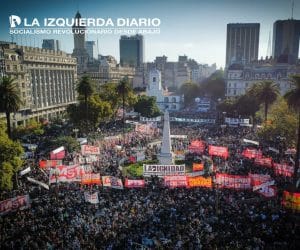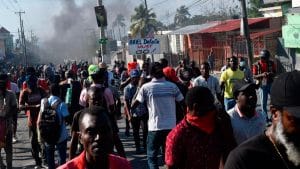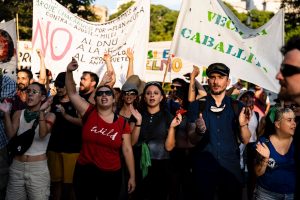Twelve days of mass mobilizations were met with violent repression in Ecuador. Indigenous people, dressed in traditional Andean clothes, stood next to impoverished youth as they confronted tear gas and armored cars. They demanded the end of decree 833, which cut fuel subsidies. Some demanded the ousting of President Lenín Moreno and the IMF.
Finally, on Sunday night, after 12 days of massive protests and two days of negotiations with indigenous leaders, President Moreno announced that he would revoke decree 833 and revert fuel prices back to their former levels. Part of the deal was to create a special commission made up of indigenous leaders and other social organizations to “address the country’s deficit” and decide on new austerity measures. In return, the Confederation of Indegenous Nationalities of Ecuador (CONAIE) called off the protests and declared victory.
The streets of Quito were jubilant. They filled with protestors who had, only hours before, been throwing rocks at the police. Across the world, this was lauded as a massive victory for the Ecuadorian masses. Without a doubt, this was a victory, but it was a partial one.
The Context
Ecuador is one of the smallest countries in South America, with a population of a little over 16.7 million and a comparatively massive foreign debt: $49.7 billion. In this sense, it is fair to say that for much of recent Ecuadorian history, imperialists’ interests have played a central role in dictating Ecuadorian policy. As a result of this intervention, in just the past 25 years, three Ecuadorian Presidents have been ousted by massive indigenous and working class protests: Abdalá Bucaram in 1997, Jamil Mahuad in 2000 and Lucio Gutiérrez in 2005. All of these removals have occurred as a result of neoliberal and IMF-imposed austerity measures.
For 10 years, the Ecuadorian economy grew and there were no large-scale attempts to oust the president from power. From 2007-2017, Rafael Correa, the Ecuadorian manifestation of the Pink Tide, governed the country. The country benefited from the high prices of commodities and an alliance with other Pink Tide governments—like those in Venezuela, Bolivia, and Brazil—and poverty rates fell. But, in the last years of Correa’s three-term Presidency, an economic crisis hit Latin America: prices of commodities dropped and right wing governments replaced former allies. In this context, Correa showed his true colors: when push comes to shove, he is on the side of the capitalist class. He began to institute repression against his former allies in the indigenous, workers, and student movements, in addition to implementing austerity measures.
Lenín Moreno, the current president of Ecuador, came to power endorsed by Correa and was perceived to be a progressive response to the hardline neoliberal Ecuadorian right made up of elite bankers and large landowners. Since Moreno took office, however, he has governed as a true neoliberal, pushing trade liberalization, cuts in public spending, and deals with the IMF. He allied with Donald Trump against Venezuela, handed over Julian Assange to the British, and ensured that the working class and indigenous peasants will be the ones to pay for the economic crisis. Moreno and Correa broke ties almost as soon as Moreno took office; Correa subsequently fled to a self-imposed exile in Belgium in order to avoid persecution and charges of corruption and misuse of power.
In March, Moreno negotiated a deal with the IMF for a loan of $4.2 billion. As part of the conditions of the agreement, the IMF required the enforcement of an austerity program that has pushed the economy further into recession—on the promise that someday the measures will alleviate the economic crisis. That day has yet to come. Specifically, the IMF demands that Ecuador implement cuts that equal 6% of the GDP over the next three years, which is sure to result in mass unemployment and poverty. The IMF agreement also demands layoffs, wage cuts, and loosening labor laws. These kinds of deals with the IMF have wreaked havoc all around the world—most recently resulting in massive mobilizations in Haiti and Puerto Rico.
Decree 833 and Mass Protests
On October 1, Moreno announced Decree 883, as part of the loan agreement with the IMF. It included a 20% cut in public sector spending, adversely affecting wages and workers. It stipulated the implementation of a tax reform that would force workers to lose one day of pay a month and cut workers’ vacation days in half. The decree also included the removal of import tariffs and fuel subsidies that had been in place for 40 years. As a result, the price of fuel doubled overnight.
Ecuador exploded in protest. The mobilizations were centered in Quito, the capital of Ecuador, and thousands of indigenous people from around the country traveled to Quito to take part. The indigenous organization CONAIE, formed in 1986, played a central role in mobilizing indigenous sectors of society- as well as placing limits on the struggle. Sectors associated with bankers and the Ecuadorian right wing even attempted to organize volunteers to physically bar indigenous people from entering Quito. It did not work.
Protesters blocked roads, took police hostage, and occupied six oil wells, which stopped production for days. They blocked the roads to Quito’s airport and set the Controller General’s office on fire. Ecuador’s economy lost some $3bn during the protests. Moreno was forced to move his administration to Guayaquil, a coastal town far from the mobilizations in Quito.
On October 11, U.S. Secretary of State Mike Pompeo issued an official “United States Response to Protests in Ecuador” declaration which stated that “the United States supports President Moreno and the Government of Ecuador’s efforts to institutionalize democratic practices and implement needed economic reforms.” This is no wonder. After all, the United States is the primary political force behind the IMF.
Moreno was intransigent in the face of these protests, responding with brute force. He announced a state of emergency, militarizing Quito and attacking protestors. Curfew was set up to keep people off the streets. The repressions reached such a level that Amnesty International demanded “an immediate end to the heavy-handed repression of demonstrations, including mass detentions, and…swift, independent and impartial investigations into all allegations of arbitrary arrests, excessive use of force, torture and other ill-treatment.” According to indigenous leaders, 10 people were killed, 2,000 were injured and over 1,000 were detained (official government statistics say that only 7 people were killed).
In this context, sectors of the masses began to make more radical demands—not only the revocation of decree 883, but also the resignation of Moreno. However, the leadership of the CONAIE and of the labor union United Workers Front (FUT), along with student organizations led by Maoist groups, did not take up this second, more radical, demand. CONAIE demanded the repeal of 883, the resignation of the Minister of the Government [the equivalent of the Prime Minister], the Minister of Defense, the release of those detained, and an end to the repression for the duration of the negotiations. They argued that everyone who called for Moreno’s resignation was with Correa and disciplined sectors of the movement that engaged in more radical slogans and more radical actions like throwing rocks at police.
What happened in negotiations?
As the mobilizations became more radical, it was clear that Correa did not lead the people who were demanding “Fuera Moreno” (out with Moreno). Sectors of the masses took up this call, particularly in the working class neighborhoods of Quito where barricades were set up. As a result, the CONAIE, who wanted to maintain the protests within the strict limits of repealing 883 agreed to sit down for negotiations.
Initially, CONAIE said they would only meet with the government if they released prisoners and terminated the state of emergency. Although neither of those conditions were met, on Saturday the CONAIE leadership agreed to sit down to televised negotiations with Lenín Moreno. Also at the negotiating table were the UN and Church leaders, acting as mediators—their goal was to end the massive protests that were sweeping the nation.
During the initial round of negotiations, the government was reluctant to revoke the decree and insisted that fuel subsidies only benefitted drug traffickers and speculators. The government also claimed that the violent mobilizations were led by ex-president Rafael Correa, who was attempting to divide the indigenous movement from the protesters in the city. CONAIE leaders agreed with the preposterous myth that Correa was orchestrating the “violence” in the protests all the way in Belgium, 5,914 miles away from the demonstrations.
But this was a fallacy, as some indigenous leaders recognized. Leonidas Iza, the president of the Cotopaxi movement, was forced to admit that the demonstrations went far beyond Correa. He said, “it seems irresponsible to me to think these actions are simple acts of vandalism from Correa followers. We are not sensing what is going on. We, ourselves, are even amazed with the amount of people participating.”
By Sunday, the government wanted to reach an agreement to “restore peace.” The mobilizations were spreading and taking a more radical and spontaneous character. Mobilizations had spread to the poorest neighborhoods of Quito, and barricades were being set up. These protestors did not answer to the leadership of the CONAIE, which had hegemonized the protests the previous week. In these neighborhoods, the demand “Out with Moreno!” was of central importance, even more so than the demand to reinstate fuel subsidies.
Both the government and the indigenous leaders reached a resolution on Sunday after a two hour recess from the televised negotiations. Moreno agreed to rescind decree 883. The agreement was read by a UN representative: “As a result of the dialogue, decree 833 has been left with no effect and a new decree will be elaborated by a newly-formed commission.” The state of emergency which was imposed on October 3, as well as the curfew, were suspended. The commission will be formed by the government and the indegenous leaders. In return the latter promised to cease the nationwide mobilizations.
The final agreement was not voted on by the assemblies that had begun to emerge in Quito during the mobilizations. It does not address the government’s responsibility for the violent repression unleashed over the week and a half of demonstrations. It does not mention the protestors who have died or have been injured, nor does it say anything about the resignation of the Interior Minister or the Defense Minister, which were demands of the protestors.
Even though president Moreno has suffered a great blow in having to revoke the decree, he has managed, via the negotiating table, to stay in power despite unleashing a brutal repression on the people of Ecuador. Meanwhile, no details have been given about the new decree the government will develop in conjunction with the indigenous leaders.
A Partial Victory
Ecuadorians were jubilant over the results of the protests. They had won. After 12 days of brutal struggle in the streets, the indigenous movement and working class people of Ecuador forced Moreno to back down from a brutal austerity plan. Despite the fact that 8 people died and thousands were injured, leaders of the CONAIE organized a “community cleanup” the next day. Protesters cleaned the streets of Quito, sometimes alongside the police who had only a 24 hours before had brutally repressed them.
These protests won the popular support of people all over the country, forcing the president’s hand. That is, without a doubt, a victory in the face of death and brutal repression. The Ecuadorian struggle and resistance is particularly relevant here in the U.S.: while the Democrats #Resist via Russiagate and maneuver for impeachment, the Ecuadorian people have shown how to effectively fight austerity and the president.
However, it must be seen as a partial and unstable victory. Already, Moreno is attacking people in Ecuador who are loyal to Rafael Correa. On Monday morning, Ecuador’s attorney general announced on Twitter that after ‘investigations,’ three supporters of former President Correa had been detained—Paola Pabón, Christian González, and Pablo Del Hierro. This is clear political persecution against Moreno’s political opposition under the guise of restoring order after the protests. Political attacks and persecution may continue in order to fend off other mass mobilizations. After all, Moreno was not forced to admit any wrongdoing for the death and injury of thousands.
Moreover, Moreno’s attempts to get funds from the IMF remain. The Nation says that some reports “indicate that the Moreno government will stick to the austerity and other commitments that he made to the IMF in return for a $4.2 billion loan.” Moreno has made it clear: there will be austerity. It may not be fuel subsidies, but it will be something else.
The mobilizations could have gone for more. It seems that there was the will for further protests. But the CONAIE played the role of containing the mobilizations and aborting them before the more radical demands were met. By limiting itself to ending decree 883, CONAIE put a strict limit on the protests, refusing to even take up the ousting of Moreno.
In the end, neither the opposition led by Correa nor the CONAIE were interested in questioning the capitalist and imperialist system that imposes misery on the masses. In this sense, they prevented the mass movement from gaining a perspective that could attack the ruling class and the system as a whole. The truth is that the only real way out of the crisis is the ousting of the IMF from Ecuador, expropriating the imperialists and the capitalists, and forming a government of the workers and indigenous people.
For now, however, Moreno was forced to back down. And this is a lesson to the working class, poor, and oppressed in the region and around the world on how to fight the austerity measures and attacks led by the IMF.
Parts of this article are based on article that appeared on La Izquierda Diario on Monday, October 14, 2019











